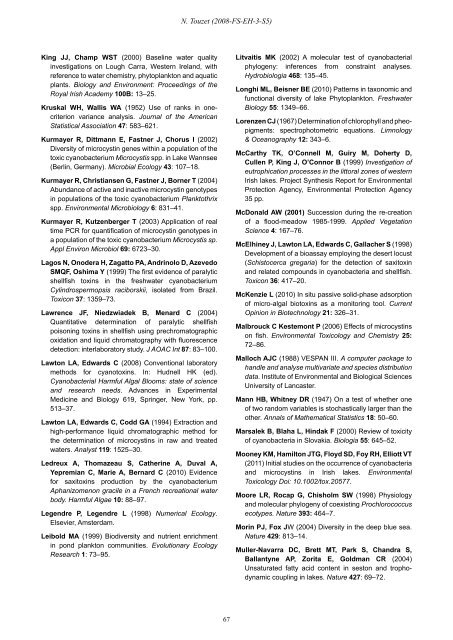STRIVE - Environmental Protection Agency
STRIVE - Environmental Protection Agency
STRIVE - Environmental Protection Agency
You also want an ePaper? Increase the reach of your titles
YUMPU automatically turns print PDFs into web optimized ePapers that Google loves.
King JJ, Champ WST (2000) Baseline water quality<br />
investigations on Lough Carra, Western Ireland, with<br />
reference to water chemistry, phytoplankton and aquatic<br />
plants. Biology and Environment: Proceedings of the<br />
Royal Irish Academy 100B: 13–25.<br />
Kruskal WH, Wallis WA (1952) Use of ranks in onecriterion<br />
variance analysis. Journal of the American<br />
Statistical Association 47: 583–621.<br />
Kurmayer R, Dittmann E, Fastner J, Chorus I (2002)<br />
Diversity of microcystin genes within a population of the<br />
toxic cyanobacterium Microcystis spp. in Lake Wannsee<br />
(Berlin, Germany). Microbial Ecology 43: 107–18.<br />
Kurmayer R, Christiansen G, Fastner J, Borner T (2004)<br />
Abundance of active and inactive microcystin genotypes<br />
in populations of the toxic cyanobacterium Planktothrix<br />
spp. <strong>Environmental</strong> Microbiology 6: 831–41.<br />
Kurmayer R, Kutzenberger T (2003) Application of real<br />
time PCR for quantification of microcystin genotypes in<br />
a population of the toxic cyanobacterium Microcystis sp.<br />
Appl Environ Microbiol 69: 6723–30.<br />
Lagos N, Onodera H, Zagatto PA, Andrinolo D, Azevedo<br />
SMQF, Oshima Y (1999) The first evidence of paralytic<br />
shellfish toxins in the freshwater cyanobacterium<br />
Cylindrospermopsis raciborskii, isolated from Brazil.<br />
Toxicon 37: 1359–73.<br />
Lawrence JF, Niedzwiadek B, Menard C (2004)<br />
Quantitative determination of paralytic shellfish<br />
poisoning toxins in shellfish using prechromatographic<br />
oxidation and liquid chromatography with fluorescence<br />
detection: interlaboratory study. J AOAC Int 87: 83–100.<br />
Lawton LA, Edwards C (2008) Conventional laboratory<br />
methods for cyanotoxins. In: Hudnell HK (ed).<br />
Cyanobacterial Harmful Algal Blooms: state of science<br />
and research needs. Advances in Experimental<br />
Medicine and Biology 619, Springer, New York, pp.<br />
513–37.<br />
Lawton LA, Edwards C, Codd GA (1994) Extraction and<br />
high-performance liquid chromatographic method for<br />
the determination of microcystins in raw and treated<br />
waters. Analyst 119: 1525–30.<br />
Ledreux A, Thomazeau S, Catherine A, Duval A,<br />
Yepremian C, Marie A, Bernard C (2010) Evidence<br />
for saxitoxins production by the cyanobacterium<br />
Aphanizomenon gracile in a French recreational water<br />
body. Harmful Algae 10: 88–97.<br />
Legendre P, Legendre L (1998) Numerical Ecology.<br />
Elsevier, Amsterdam.<br />
Leibold MA (1999) Biodiversity and nutrient enrichment<br />
in pond plankton communities. Evolutionary Ecology<br />
Research 1: 73–95.<br />
N. Touzet (2008-FS-EH-3-S5)<br />
67<br />
Litvaitis MK (2002) A molecular test of cyanobacterial<br />
phylogeny: inferences from constraint analyses.<br />
Hydrobiologia 468: 135–45.<br />
Longhi ML, Beisner BE (2010) Patterns in taxonomic and<br />
functional diversity of lake Phytoplankton. Freshwater<br />
Biology 55: 1349–66.<br />
Lorenzen CJ (1967) Determination of chlorophyll and pheopigments:<br />
spectrophotometric equations. Limnology<br />
& Oceanography 12: 343–6.<br />
McCarthy TK, O’Connell M, Guiry M, Doherty D,<br />
Cullen P, King J, O’Connor B (1999) Investigation of<br />
eutrophication processes in the littoral zones of western<br />
Irish lakes. Project Synthesis Report for <strong>Environmental</strong><br />
<strong>Protection</strong> <strong>Agency</strong>, <strong>Environmental</strong> <strong>Protection</strong> <strong>Agency</strong><br />
35 pp.<br />
McDonald AW (2001) Succession during the re-creation<br />
of a flood-meadow 1985-1999. Applied Vegetation<br />
Science 4: 167–76.<br />
McElhiney J, Lawton LA, Edwards C, Gallacher S (1998)<br />
Development of a bioassay employing the desert locust<br />
(Schistocerca gregaria) for the detection of saxitoxin<br />
and related compounds in cyanobacteria and shellfish.<br />
Toxicon 36: 417–20.<br />
McKenzie L (2010) In situ passive solid-phase adsorption<br />
of micro-algal biotoxins as a monitoring tool. Current<br />
Opinion in Biotechnology 21: 326–31.<br />
Malbrouck C Kestemont P (2006) Effects of microcystins<br />
on fish. <strong>Environmental</strong> Toxicology and Chemistry 25:<br />
72–86.<br />
Malloch AJC (1988) VESPAN III. A computer package to<br />
handle and analyse multivariate and species distribution<br />
data. Institute of <strong>Environmental</strong> and Biological Sciences<br />
University of Lancaster.<br />
Mann HB, Whitney DR (1947) On a test of whether one<br />
of two random variables is stochastically larger than the<br />
other. Annals of Mathematical Statistics 18: 50–60.<br />
Marsalek B, Blaha L, Hindak F (2000) Review of toxicity<br />
of cyanobacteria in Slovakia. Biologia 55: 645–52.<br />
Mooney KM, Hamilton JTG, Floyd SD, Foy RH, Elliott VT<br />
(2011) Initial studies on the occurrence of cyanobacteria<br />
and microcystins in Irish lakes. <strong>Environmental</strong><br />
Toxicology Doi: 10.1002/tox.20577.<br />
Moore LR, Rocap G, Chisholm SW (1998) Physiology<br />
and molecular phylogeny of coexisting Prochlorococcus<br />
ecotypes. Nature 393: 464–7.<br />
Morin PJ, Fox JW (2004) Diversity in the deep blue sea.<br />
Nature 429: 813–14.<br />
Muller-Navarra DC, Brett MT, Park S, Chandra S,<br />
Ballantyne AP, Zorita E, Goldman CR (2004)<br />
Unsaturated fatty acid content in seston and trophodynamic<br />
coupling in lakes. Nature 427: 69–72.

















